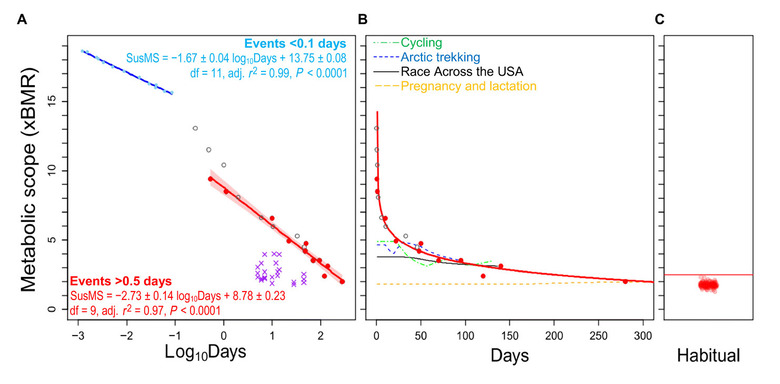Human endurance cap calculated: Here's where you hit the wall
In a study published this week, researchers have calculated the limit of human endurance. The study used data from human endurance events and transcontinental races to track Basal Metabolic Rate (BMR) (also called metabolic scope) and maximum sustained metabolic scope (SusMS) with regard to event duration. They've also found a limit for habitual metabolic scope (physical activity level) in general.
Calculating BMR requires that you know your weight, height, age, and sex (male or female). There are studies which suggest that further research needs to be done on how sex affects BMR. At this time, it's generally accepted that the differences (as reflected here in the equations) account for male and female average tendencies to have different amounts of lean body mass and fat cells.
BMR (Basal Metabolic Rate) Equation
• For women: BMR = (10 × weight in kg) + (6.25 × height in cm) – (5 × age in years) – 161
• For men: BMR = (10 × weight in kg) + (6.25 × height in cm) – (5 × age in years) + 5
The conclusion of this study showed that no human can burn calories faster than 2.5 times their BMR. That rate is capped in this study specifically during physical activities that last for extended periods of time. Humans are capable of far higher calorie burn rates over short periods of time.
According to earlier studies, "maximum sustained metabolic scope (SusMS) is capped at ~4× to 5× BMR in humans and other endotherms" – and "approaching ~7× BMR for some rodents under cold conditions." Those studies centered on a 23-day Tour de France.
This newest study collected further test data taken from 11-hour triathlons and 25-hour ultramarathons. These shorter events resulted in max burn at 9.4× and 8.5× BMR, respectively. Below you'll see a set of graphs showing results from this most recent study, which took into account activities spanning 0.5 to 95 days.

Above in graph B, "SusMS versus duration relationship [unlogged and redrawn from (A); analysis A in table S2] flattens out at ~2.5× BMR." In graph C: "Habitual metabolic scope ("physical activity level") for n = 130 cohorts from a diverse global sample cluster below 2.5× BMR (red line)."
This study is a landmark in sports and human history to which all extreme endurance athletes should pay heed. What'll be interesting is seeing whether this rate differs across time. I wouldn't be shocked to find that several hundred years ago, similar tests would yield significantly different results.
To learn more about this subject, take a peek at the research paper entitled "Extreme events reveal an alimentary limit on sustained maximal human energy expenditure." With code DOI: 10.1126/sciadv.aaw0341 you'll find this article in Science Advances, on the 5th of Jun 2019: Vol. 5, no. 6. This paper was authored by Caitlin Thurber, Lara R. Dugas, Cara Ocobock, Bryce Carlson, John R. Speakman, and Herman Pontzer.
